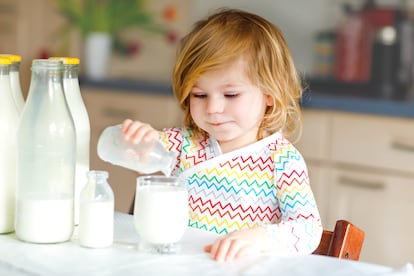What is the difference between a milk allergy and lactose intolerance?
While not tolerating this substance means that it cannot be properly digested, an allergic reaction is an atypical response from the immune system that can put the child’s life at risk

The suitability of feeding children with cow’s milk is usually questioned without the support of scientific evidence, with people claiming that its consumption worsens the symptoms of asthma or that it raises cholesterol levels, common statements among the mothers and fathers of schoolchildren. Pediatricians, however, answer to this with a resounding no. “These beliefs are false, as is the fact that lactose intolerance in young children is forever; it is usually transitory and is overcome spontaneously,” explains Iván Carabaño, associate professor of pediatrics at the Complutense University of Madrid. Carabaño claims that milk is a complete food for the children and that human beings have efficient machinery to process it, so if it is tolerated there is no need to stop drinking it.
The appropriate amount of milk for kids varies, depending on their age. According to the U.S. Department of Agriculture, the recommended daily amounts for children and teenagers are, from two to three years of age, two cups (16 ounces); four to eight years, two and a half cups (20 ounces); and from nine to 18 years, three cups (24 ounces). “During adolescence, more calcium is required,” continues the pediatrician, “and it is reasonable to increase its intake, as well as consuming other dairy products, to build strong bones during growth.” Carabaño adds that calcium is also found in other foods such as legumes, nuts and canned fish.
“In addition, if the mother doesn’t breastfeed the baby, starting at one year of age they can be given a glass of whole milk and yogurt as part of their diet,” explains Laura Llorente, nutritionist and psychologist at the Centta Institute, a psychology clinic in Madrid, Spain. “Milk is a complete food because it also provides protein (casein), phosphorus, carbohydrates, vitamins A, B and D and minerals,” emphasizes the expert. According to the Spanish Association of Pediatrics, every 100 milliliters (3.4 ounces) of milk provide about 60 to 65 calories.
What happens if the child does not tolerate milk
Carabaño explains that cow’s milk also contains lactose — milk sugar — and can cause intolerance that translates into symptoms such as abdominal pain, flatulence, watery diarrhea and redness in the diaper area, in the case of babies. “Between 10% and 20% of the child population is lactose intolerant,” he continues, “and its diagnosis is made after breath tests or a genetic test.”
“In the case of children under six, lactose malabsorption is very rare, and it increases with age, reaching its peak between 10 and 16 years of age,” explains José Carlos Marín, scientific director of the Clinical Institute of the Digestive System, in Madrid. “Tolerance varies depending on how much is ingested. In any case, people with lactose intolerance tend to assimilate a certain amount of this sugar well; usually the equivalent of a glass of milk a day, around 10 grams of lactose a day.”
Lactose intolerance, Marín continues, appears when this substance cannot be properly digested; when it is not absorbed by the intestine, irritation occurs in the digestive system. According to the expert, children who have the genetic variant that causes lactose intolerance are as healthy as those who have the one that allows them to consume it normally; the treatment, he points out, can be as easy as replacing milk with a product that does not have lactose.
Intolerance does not equal allergy
“Lactose doesn’t usually cause a food allergy, which is an atypical response of the immune system that is usually caused by the proteins that are present in this food, such as casein, lactoglobulins and bovine antibodies,” adds Marín. “In this case, children often suffer from intestinal irritations such as chronic diarrhea, little weight gain, vomiting and lack of energy,” explains Carabaño. When there is an allergic reaction, it happens immediately after the child consumes it, and the symptoms can range from mild to severe; in addition to those previously mentioned, there can be wheezing, hives and anaphylaxis, a serious reaction that can put the child’s life at risk, according to the Mayo Clinic.
“The allergy usually appears during the first three years of life, after that it is very unusual,” adds Marín. This expert explains that it is rare in teenagers, although it is one of the most frequent at four years of age. Minors who suffer from it must follow a strict diet free of cow’s milk proteins. “If the child drinks an artificial milk formula, it would be replaced with one that contains hydrolyzed cow’s milk,” Carabaño exemplifies. For her part, Llorente points out that the consumption of dairy products is not essential: “It has been sold as a star product, as the main source of calcium and protein, but that is not the only food from which these nutrients can be obtained. They are also present in plant-based beverages, such as oatmeal or almond beverages.”
Sign up for our weekly newsletter to get more English-language news coverage from EL PAÍS USA Edition
Tu suscripción se está usando en otro dispositivo
¿Quieres añadir otro usuario a tu suscripción?
Si continúas leyendo en este dispositivo, no se podrá leer en el otro.
FlechaTu suscripción se está usando en otro dispositivo y solo puedes acceder a EL PAÍS desde un dispositivo a la vez.
Si quieres compartir tu cuenta, cambia tu suscripción a la modalidad Premium, así podrás añadir otro usuario. Cada uno accederá con su propia cuenta de email, lo que os permitirá personalizar vuestra experiencia en EL PAÍS.
¿Tienes una suscripción de empresa? Accede aquí para contratar más cuentas.
En el caso de no saber quién está usando tu cuenta, te recomendamos cambiar tu contraseña aquí.
Si decides continuar compartiendo tu cuenta, este mensaje se mostrará en tu dispositivo y en el de la otra persona que está usando tu cuenta de forma indefinida, afectando a tu experiencia de lectura. Puedes consultar aquí los términos y condiciones de la suscripción digital.











































